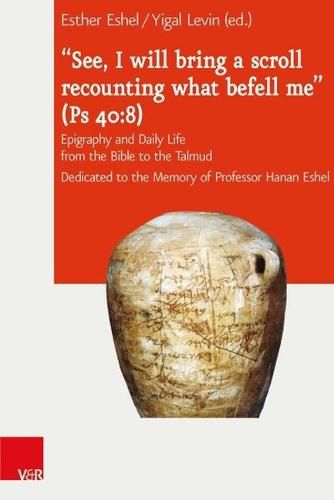Readings Newsletter
Become a Readings Member to make your shopping experience even easier.
Sign in or sign up for free!
You’re not far away from qualifying for FREE standard shipping within Australia
You’ve qualified for FREE standard shipping within Australia
The cart is loading…






In January 2011, the David and Jemima Jeselsohn Epigraphic Center for Jewish History held its second international conference at Bar-Ilan University, dedicated to the memory of Professor Hanan Eshel, the founding academic director of the center who passed away on April 8th, 2010. This collection of articles, traces, when taken together, daily life in the land of Israel from the First Temple Period through the time of the Talmud, as seen in the various types of inscriptions from those periods that have been discovered and published. Schiffman’s summary of Hanan’s work serves as an introduction to the book. Ahituv discusses the language and religious outlook of the Kuntilet Ajrud inscriptions. Mazar and Ahituv survey the quite large corpus of short inscriptions found in Mazar’s excavation of Tel Reov, south of Beth-Shean. Maeir and Eshel deal with four very short more-or-less contemporary inscriptions found at Tell es-Safi, identified as the major Philistine city of Gath. Demsky deals with the theoretical aspects of literacy in ancient Israel. Grabbe discusses the functions of the scribe during the Second Temple Period. Zissu, Langford, Ecker and Eshel report on both an Aramaic-language graffito and a Latin one, inscribed on the wall of a first and 2nd century CE oil press from of the Judean Shephelah. Rappaport’s survey of Jewish coins from the Persian Period through the Bar-Kokhba Revolt, focusing on the Hasmonean coins. Amit describes a group of bread stamps and oil seals, in Hebrew, Aramaic, Greek and Latin, found in different parts of the country. Klein and Mamalya describe two Byzantine Period Nabatean Christian burial sites and their epitaphs.
$9.00 standard shipping within Australia
FREE standard shipping within Australia for orders over $100.00
Express & International shipping calculated at checkout
In January 2011, the David and Jemima Jeselsohn Epigraphic Center for Jewish History held its second international conference at Bar-Ilan University, dedicated to the memory of Professor Hanan Eshel, the founding academic director of the center who passed away on April 8th, 2010. This collection of articles, traces, when taken together, daily life in the land of Israel from the First Temple Period through the time of the Talmud, as seen in the various types of inscriptions from those periods that have been discovered and published. Schiffman’s summary of Hanan’s work serves as an introduction to the book. Ahituv discusses the language and religious outlook of the Kuntilet Ajrud inscriptions. Mazar and Ahituv survey the quite large corpus of short inscriptions found in Mazar’s excavation of Tel Reov, south of Beth-Shean. Maeir and Eshel deal with four very short more-or-less contemporary inscriptions found at Tell es-Safi, identified as the major Philistine city of Gath. Demsky deals with the theoretical aspects of literacy in ancient Israel. Grabbe discusses the functions of the scribe during the Second Temple Period. Zissu, Langford, Ecker and Eshel report on both an Aramaic-language graffito and a Latin one, inscribed on the wall of a first and 2nd century CE oil press from of the Judean Shephelah. Rappaport’s survey of Jewish coins from the Persian Period through the Bar-Kokhba Revolt, focusing on the Hasmonean coins. Amit describes a group of bread stamps and oil seals, in Hebrew, Aramaic, Greek and Latin, found in different parts of the country. Klein and Mamalya describe two Byzantine Period Nabatean Christian burial sites and their epitaphs.